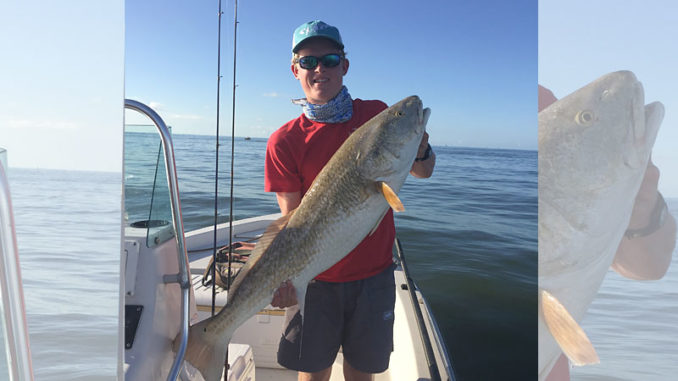
Guide explains tides, lures and casting strategies
Watching Curtis LeNormand sight-cast for redfish in the marsh is kind of like watching NFL quarterbacks tear apart an opponent’s secondary, deftly placing the ball into receivers’ hands in stride.
It didn’t matter if they were throwing a middle route over the pond, tossing a screen pass left or right along the edge of the marsh or going deep with a Hail Mary toss to a redfish trying to make a break for it — LeNormand’s baitcasting outfit consistently delivered his lure within a few feet of the fish’s head.
LeNormand has been sight-fishing since he was a kid, and it shows.
Here are some of his top tips to help you connect with more reds in the marsh:
Fish the tides
“In the ponds, you definitely want a little more water. But you don’t want it super high, because then the fish could be everywhere,” said LeNormand. “You want a mid-range tide. That way, you can still get across the shallow ponds, but the fish can’t get way back in the marsh.”
If the tides don’t cooperate on your a fishing day, LeNormand moves to Plan B.
“If you can’t get in the ponds, find a (ditch) where the bait is coming out, and you know the fish have to come out at that exit point. Set up right there,” he said. “Stay the end-of-your-casting-distance away from the mouth of that cut. And just wait for those fish — sometimes you might see them, sometimes you might not.
“If you can’t get them to bite and it’s dirty, maybe try a cork and shrimp. Just stay in the mouth of the cut a good-enough ways away so you won’t spook them.”
Match lures to conditions
Depending on how fish are reacting on a particular day, don’t just assume your favorite setup will automatically work again.
“The thing with spinnerbaits in that shallow water is that it sometimes makes them a little skittish,” he said. “It can almost be a little too aggressive and spook them more than anything.”
When less is more, LeNormand switches to a Z-Man Chatterbait or a straight H&H cocahoe on either a ¼- or 1/8-ounce jighead.
“Eighth-ounce would probably be better as far as presentation when it hits the water, but you can’t cast as far,” he said. “In darker water, I use darker baits. For clear water, you want some kind of sparkle, like purple/chartreuse with glitter in it — any kind of see-through bait with glitter.
“In murky water, you want to throw purple, or black/chartreuse and white/chartreuse — a solid color. And when it’s tough and the fish are finicky, you should switch to Gulp! because of the scent, especially in murky water.”
Practice-casting scenarios
“For a redfish moving left to right, you want to try to get at least a foot in front of him. Always throw past him and work it back right in front of his face and just kind of bounce it,” LeNormand said. “A fish coming straight to you is the hardest one. You don’t want to throw over his back. If you touch him in any way, you’re not going to get him unless they’re feeding in schools competing.
“If he’s veering slightly left, throw on the left side. If you can, throw it about 3 feet in front of him and let it sit. When he gets to it, twitch it.”
The key is to make your lure appear that it’s reacting to the presence of the redfish, just like a real baitfish would do, he said.
“Anytime they’re finicky, you definitely want to give them at least a foot, and sometimes maybe even 4 or 5 feet. Pull it out the mud and let it set, and let him come to your bait,” he said. “Right when it gets there, twitch it. That way, the fish feels like he spooked the bait, instead of the bait looking like it’s just going past.”
LeNormand fishes with 20- to 30-pound Fins WindTamer braid and a 30-pound fluorocarbon leader when he’s targeting reds in the marsh.
Fill ‘er up, not too Full
Depending on how much water your boat draws, extra, unnecessary weight could be the difference in being able to make it to a back pond in the marsh stacked with tailing reds.
“If you’re going sight-fishing, definitely keep only 10 or 15 gallons more than you think you’ll need,” LeNormand said. “Don’t fill up your boat. More than likely, you’ll be in some skinny water. You don’t want too much fuel.”
Learn redfish wakes
A pond will hopefully be teeming with activity from redfish, mullet, shrimp, pogeys and any variety of bait. As you’re moving through the ponds, you have to be able to distinguish redfish and cast to them.
“Most of the time, a big — like 2 or 3 pounds — they’ll push a wake like a small redfish; they can definitely trick anybody, and I’ve been guiding 13 years,” LeNormand said. “But a redfish over 22 inches will usually push a good ‘V’ that you won’t mistake for anything else.
“When you see a mullet and a redfish side-by-side, you’ll see the difference. A redfish looks like a submarine underwater — he’ll push a pretty good wake.”
The speed of the wake can help you pick out redfish as well, he said.
“Mullet will usually run a little faster. They have a sporadic run, here and there, and don’t stay at a steady pace,” he said. “When a redfish is pushing, it’s going to be a steady pace the whole time. If you see a spurt from a red, he’s spooked and gone. You’re probably not going to get him.”


Be the first to comment